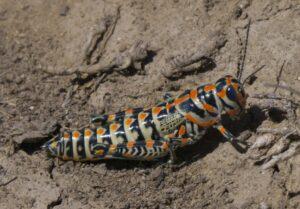Rainbow Grasshopper (Dactylotum bicolor)
Updated on
11/01/2023The rainbow grasshopper gets its name from the vibrant color patterns of its exoskeleton. The dazzling colors serve the evolutionary purpose of warning away predators. It is known throughout the North American continent under many other names such as – pictured grasshopper, painted grasshopper, and barber pole grasshopper.
Scientific Classification
- Class:Insecta
- Order:Orthoptera
- Family:Acrididae
- Subfamily:eMelanoplina
- Tribe:Dactylotini
- Genus:Dactylotum
- Species: Dactylotum bicolor
Conservation Status
Description
Rainbow grasshoppers are sexually dimorphic. Females are 0.6-0.8 inches (2cm) in size, compared to males, which are about 1.4 inches (3.5cm).

They come in patterns of yellow, red, and green, over a base of black. They also have pale green wing pads.
The middle segment of the hind leg, the hind tibiae, consists of 6-8 spines.
Adults of this species have short wings and are unable to fly.
The rainbow grasshopper has three recognized subspecies, with each varying in color from the other.
The first one, D. b. pictum has a black body with little red spots. It is found along the ranges of the northern and eastern parts of the U.S.
D. b. bicolor, another subspecies of the rainbow grasshopper, is found in Mexico, New Mexico, and Northern Texas. This subspecies has a violet-purple lustrous shine on top of the black exoskeleton.
The D. b. variegatum has distinct red markings on its body. It is found extensively in Southern Arizona and some of its western territories.
Distribution: Western Great Plains of U.S. to Southwestern states like Arizona, Texas, New Mexico, and southern Canada.
Habitat: Prairies, thinly vegetated areas, desert grasslands, and alfalfa fields
Do They Bite/Sting: No.
Lifespan: 1 year.
Predators: Lizards and birds
Behavior and Characteristics
Feeding
Adult rainbow grasshoppers are typically polyphagous, i.e., they eat various plants. Nymphs born in New Mexico and Arizona prefer Wright’s false willow.
The painted grasshopper feeds on various grasses and herbaceous flowering plants in sparsely vegetated areas without any particular preference for any specific species.
These grasshoppers are typically uncommon. Therefore they usually don’t pose a threat to croplands.
Thermoregulation
Rainbow grasshopper nymphs orient themselves depending on the sun’s position, placing themselves around the plant or shrub to thermoregulate, maintaining the body temperature at an acceptable range.
When the sun is full around morning and evening, they tend to feed near the ground but shift to shaded areas during midday. Predators who come during the night might pose a threat to the grasshopper, so they retire to the top branches of plants, shrubs, or bushes.
Aposematism
The bright, vibrant colors of the grasshopper act as warning signals for predators, This phenomenon is called aposematism.

An experiment conducted on rainbow grasshoppers observed their predation by introducing striped whiptail lizards. Results showed that the lizards avoided the brightly-colored grasshoppers as they were distasteful. The lizards were unfamiliar with the rainbow grasshopper(which were not a part of their natural habitat), but they still avoided them.
The lizards may previously have encountered aposematism in vibrant colored velvet ants, stink bugs, or seed bugs. They have learned that brightly colored preys are usually distasteful and should be avoided.
This may have been the reason why they avoided the rainbow grasshoppers and preferred grasshoppers of the genus Trimerotropis which displayed normal monotonous camouflages.
Experiments have also shown that birds do not prefer the rainbow grasshopper as they find them distasteful.
Life Cycle
The female grasshopper lays about a hundred eggs divided into 12 batches or masses in the soft soil, where they live through the winter and do not hatch until late spring or the onset of summer.
FAQs
Ans. Although species that display aposematism are usually toxic or poisonous, there is no indication that the rainbow grasshoppers are harmful to people or animals or carry diseases that could damage humans.
Source
lh5.ggpht.com, i.imgur.com, media.kidadl.com, pbs.twimg.com, bugguide.net










